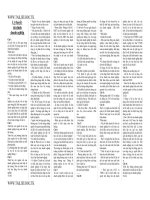Tài liệu ôn thi môn tài chính công (4)
Bạn đang xem bản rút gọn của tài liệu. Xem và tải ngay bản đầy đủ của tài liệu tại đây (58.29 KB, 2 trang )
Personal income tax (PIT) has been widely applied in the world. More than 180
countries have introduced Law on Personal income tax as a main and the most equal kind of
tax in their tax system. The proportion of revenue from Personal income tax accounted for
30%-40% of total budget revenue in developed countries, and 13%-14% of total budget
revenue in ASEAN countries such as Thailand, Malaysia, and Philippines.
In Jan-2009, HDT head-office collected PIT at VND 335 billion from 78,852
individuals at 10,665 IPBs, accounting for 6, 73% of total collection of all kinds of taxes 1
Law on PIT not only imposes huge workload to Hanoi tax system, but also enforces a
great deal of cost to TPs that consist of tax-paid and compliance cost. PIT law divides TPs
in to two kinds: resident and non-resident who are charged by 5 different tax rates to 8 kind
of capital income, 7 tax rates for 7 tax brackets levy on labour income, filling 38 various
forms of tax returns, tax registration, tax notice . . .
TalentNet Corporation announces the release of their Vietnam 2008 Total
Remuneration Survey report in first two months 2009. Participation in this survey were 124
big enterprises representing 15 different industries such as consumer goods, insurance,
medical, health care, manufacturing, petroleum, pharmaceutical, chemical, finance, and
banking . . . 95% of which were Foreign own company, and the rest is big Vietnam
companies. These enterprises agree that 2009 is undoubtedly a tougher year for businesses,
and in times like these, better utilisation of budgets and resources becomes imperative. Most
of them decided to increase employment cost against inflation at 16, 3% in two beginning
months 2009 to hold their staff, no more new recruitment, so as to help companies stay
competitive in the market. Survey report reveals the total employment cost (include salary,
bonus, subsidy, PIT, social security, and health insurance) at 120 surveyed companies (97%
of total) have expanded against Dec-2008. The growing rate is up to 20% in 52 enterprises
(42% of total) and increase from 20% to 30% in 68 enterprises (55% of total). Average
expenditure per employee was increased by 13.1%, fell by 2.2% than first two months
2008.2
The highest tax rates in Singapore, Hong Kong, and Malaysia are 20%, 17% and
27%, respectively
In the first two months 2009, the result of FDI attraction was not good as the same
previous last year. In January and February 2009, the country had attracted USD 5,328
million total registered capitals, reduced by 30 % (5328/ 7583 million) of registered capital
against first two months 2008 3.
1
Hanoi Department of Taxation, "Hanoi Department of Taxation monthly reports 2009"
Vietnam Media, " 2009, Reduction of Salary and bonus"
3
Vietnam General Statistic office report 2009, " Department of Foreign investment management report in fist two
months 2009", from www.gso.gov.vn
2
In first quarter 2009, Hanoi had 60 foreign projects newly licensed with USD 42
millions total registered capital. The number of project account for 83% (60/72) and the
investment capital account for 7% (42/575 million) in comparison with the same period last
year4.
Hanoi Department of Taxation manages 225.425 business households, among them
182.862 business households pay tax. Since 1st, Jan, 2009, this taxable business household
has decreased to 145.221 in which 13.334 business households had changed their tax
calculation method
Based on current Vietnamese socio-economic conditions, Vietnam is a country with a
high level of payment by cash, a great number of economic transactions are paid in cash, and
cash settlement volume takes 18% in total means of payment in 2008. Only high-income
individuals make their payment through the bank. In 2007, there were only 8 million
individual's bank accounts in the banks in Vietnam. This figure is estimated about 9 million
in 2008, one-fifths of 45 million employees on population of 86.16 million Vietnamese.5
Such infrastructure includes effective accounting practice, a system of transparent
property rights; expanded financial transaction systems improved the government’s
economic management ability; an independent judiciary, a corruption-free tax collection
authority and general trust in the Government...
4
5
Vietnam General Statistic office report 2009, "Hanoi first quarter 2009 report", from www.gso.gov.vn
Vietnam Ministry of Industrial and Commercial, "Vietnam e-commerce report in 2007









